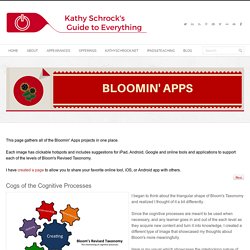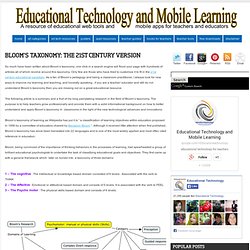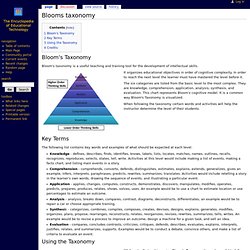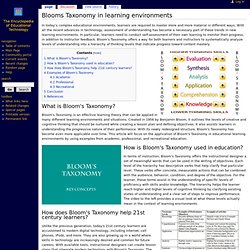

Bloom's Taxonomy. Bloom's Digital Taxonomy. Bloomin' Apps. This page gathers all of the Bloomin' Apps projects in one place.Each image has clickable hotspots and includes suggestions for iPad, Android, Google and online tools and applications to support each of the levels of Bloom's Revised Taxonomy.I have created a page to allow you to share your favorite online tool, iOS, or Android app with others.

Cogs of the Cognitive Processes I began to think about the triangular shape of Bloom's Taxonomy and realized I thought of it a bit differently.Since the cognitive processes are meant to be used when necessary, and any learner goes in and out of the each level as they acquire new content and turn it into knowledge, I created a different type of image that showcased my thoughts about Bloom's more meaningfully.Here is my visual which showcases the interlocking nature of the cognitive processes or, simply, the "Cogs of the Cognitive Processes". Bloom’s Taxonomy: The 21st Century Version.
So much have been written about Bloom’s taxonomy; one click in a search engine will flood your page with hundreds of articles all of which revolve around this taxonomy.

Only few are those who have tried to customize it to fit in the 21st century educational paradigm. As a fan of Bloom’s pedagogy and being a classroom practitioner, I always look for new ways to improve my learning and teaching, and honestly speaking , if you are a teacher/ educator and still do not understand Bloom’s taxonomy then you are missing out on a great educational resource. The following article is a summary and a fruit of my long painstaking research in the field of Bloom’s taxonomy. The purpose is to help teachers grow professionally and provide them with a solid informational background on how to better understand and apply Bloom’s taxonomy in classrooms in the light of the new technological advances and innovations. 1 – The cognitive : The intellectual or knowledge based domain consisted of 6 levels .
Bloom’s Taxonomy. By Patricia Armstrong, Assistant Director, Center for Teaching Background Information In 1956, Benjamin Bloom with collaborators Max Englehart, Edward Furst, Walter Hill, and David Krathwohl published a framework for categorizing educational goals: Taxonomy of Educational Objectives.

Familiarly known as Bloom’s Taxonomy, this framework has been applied by generations of K-12 teachers and college instructors in their teaching. The framework elaborated by Bloom and his collaborators consisted of six major categories: Knowledge, Comprehension, Application, Analysis, Synthesis, and Evaluation. The categories after Knowledge were presented as “skills and abilities,” with the understanding that knowledge was the necessary precondition for putting these skills and abilities into practice.
While each category contained subcategories, all lying along a continuum from simple to complex and concrete to abstract, the taxonomy is popularly remembered according to the six main categories. Blooms taxonomy - EET. From EET Bloom's Taxonomy Bloom’s taxonomy is a useful teaching and training tool for the development of intellectual skills.

It organizes educational objectives in order of cognitive complexity. In order to reach the next level the learner must have mastered the level before it. The six categories are listed from the basic level to the most complex. When following the taxonomy certain words and activities will help the instructor determine the level of their students. Key Terms The following list contains key words and examples of what should be expected at each level. Blooms Taxonomy in learning environments - EET. From EET In today’s complex educational environments, learners are required to master more and more material in different ways.

With all the recent advances in technology, assessment of understanding has become a necessary part of these trends in new learning environments. In particular, learners need to conduct self-assessment of their own learning to monitor their progress, in addition to instructor feedback. Do students need to learn lower-level factual and procedural knowledge before they can do higher-order thinking? There is a prevailing conception that students must learn facts and procedural knowledge BEFORE they can then engage in so-called 'higher-order' thinking skills. Educators, parents, policymakers, online commentators, and others point to Bloom's taxonomy (which typically has been portrayed as a pyramid) and say, "See? You have to do this stuff down here before you can do that stuff up top! " But that's not how Bloom and his co-authors categorized the taxonomy: Bloom et al. discussed at length their decision to apply an Aristotelian categorization method in their taxonomy.
The choice was significant, because an Aristotelian method creates distinct, bounded categories ordered by complexity without the hierarchical assumption that higher-level categories always entail instantiation of those lower in the taxonomy (e.g., when evaluating, it is not always necessary to first apply and synthesize). Similarly, as the National Research Council stated a quarter-century ago: So what? We can do better. Bloom's Digital Taxonomy. Bloom's Taxonomy Game.